Glyphosate Analysis in Foods by HPLC with Post-Column Derivatization and Fluorescence Detection
The Application Notebook
Glyphosate, the active ingredient in Roundup®, is the most widely used herbicide in the world. In the United States, the Environmental Protection Agency (EPA) regulates Glyphosate and sets maximum amount of herbicide allowed to be present in assorted crops as well as drinking water. Recent research, however, has raised concerns about Glyphosate safety and its prevalence in the environment. In response to the evidence of increased human exposure to this herbicide, the U.S. Food and Drug Administration (FDA) announced it will begin testing Glyphosate in foods including soybeans, corn, milk, and eggs.
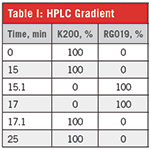
Pickering Laboratories has over 30 years of experience manufacturing and selling instruments and reagents for Glyphosate analysis in accordance to the US-EPA Method 547 for Glyphosate Analysis in Drinking Water as well as the AOAC Method 991.08 for Glyphosate Analysis in Environmental Waters. These HPLC methods are based on post-column derivatization technology with florescence detection. The AOAC Official Method 2000.05 for Analysis of Glyphosate in Crops describes an easy clean-up procedure using cation-exchange cartridges that was successfully combined with Pickering Laboratories' post-column derivatization for analysis of Glyphosate in crops such as soy, corn, alfalfa, and sunflower seeds as well as vegetables such as tomatoes and broccoli (1,2). The downside of this sample preparation technique is the fairly high volume of the water-based solution used to elute Glyphosate from the clean-up cartridge and consequently long evaporation times.
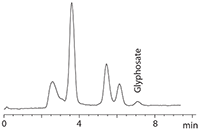
The presented post-column derivatization method for Glyphosate analysis utilizes an accelerated sample preparation procedure to quickly and efficiently analyze Glyphosate in a wide range of foods. The analytical method is sensitive and selective, and it can be easily implemented in any laboratory.
Method

Sample Preparation
Extraction
To 25 g of homogenized sample, add enough water (after estimating moisture content) such that the total volume of water is 125 mL. Blend at high speed for 3–5 min and centrifuge for 10 min. Transfer 20 mL of the aqueous extract into a centrifuge tube and add 15 mL of Methylene Chloride. Shake for 2–3 min and centrifuge for 10 min. Use the upper layer for SPE clean-up.
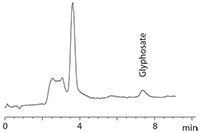
Matrix-Specific Modifications
1) For samples that absorb large amounts of water, reduce test portion to 12.5 g while keeping water volume the same.
2) For samples with high fat content, perform the Methylene Chloride partitioning twice.

SPE Cleanup
Condition the SAX cartridge with 5 mL of Methanol followed by 5 mL of D.I. water, draining the liquid to the top of the sorbent bed.Transfer 1 mL of extract into cartridge and elute to the top of the sorbent bed. Wash with 5 mL of Methanol. Elute Glyphosate with 5 mL of Elution Solution into collection vessel for evaporation. Evaporate to dryness at 55 °C under Nitrogen. Dissolve the residue in 1.5 mL of a 10% RESTORE™ in water solution. Filter through a 0.45 µm syringe filter and inject onto the HPLC column.
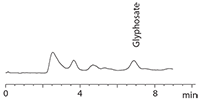
Conclusion
The simple and robust post-column method was shown to be suitable for analysis of Glyphosate on sub-ppm levels in many types of foods. Accelerated sample preparation improves throughput of samples and reduces cost of testing for busy laboratories. The sensitivity of the method allows for detection of Glyphosate well below residue tolerances set by regulatory agencies.
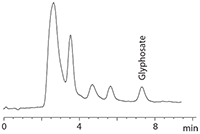
References
(1) Pickering Laboratories method abstract MA207 "Glyphosate Analysis in soy beans, corn and sunflower seeds"
(2) Pickering Laboratories method abstract MA206 "Glyphosate and AMPA Analysis in crops"

Pickering Laboratories, Inc.
1280 Space Park Way, Mountain View, CA 94043
tel. (800) 654-3330, (650) 694-6700
Website: www.pickeringlabs.com

New Study Reviews Chromatography Methods for Flavonoid Analysis
April 21st 2025Flavonoids are widely used metabolites that carry out various functions in different industries, such as food and cosmetics. Detecting, separating, and quantifying them in fruit species can be a complicated process.
Analytical Challenges in Measuring Migration from Food Contact Materials
November 2nd 2015Food contact materials contain low molecular weight additives and processing aids which can migrate into foods leading to trace levels of contamination. Food safety is ensured through regulations, comprising compositional controls and migration limits, which present a significant analytical challenge to the food industry to ensure compliance and demonstrate due diligence. Of the various analytical approaches, LC-MS/MS has proved to be an essential tool in monitoring migration of target compounds into foods, and more sophisticated approaches such as LC-high resolution MS (Orbitrap) are being increasingly used for untargeted analysis to monitor non-intentionally added substances. This podcast will provide an overview to this area, illustrated with various applications showing current approaches being employed.

.png&w=3840&q=75)

.png&w=3840&q=75)



.png&w=3840&q=75)



.png&w=3840&q=75)














